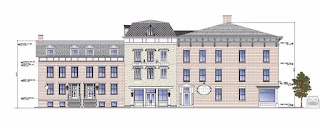I don't know anyone who likes the street furniture proposed by Arterial for the Hudson Connects project, and people have not been shy about sharing their opinion that it looks like something worthy of a suburban shopping mall somewhere in the Sun Belt, but the design keeps coming back.
This morning, James Ribaudo of Arterial made a long-awaited presentation to the Historic Preservation Commission. Regarding street furniture, Ribaudo told the HPC that they were accepting a suggestion that the Central Park style benches being used in the new Promenade Hill plaza be continued as street furniture and indicated that these benches would be used at locations along Front Street.
Elsewhere in the BRIDGE District, the same palette of street furniture was being proposed. (The category of street furniture includes not only benches but also tree pit guards, bike racks, bollards, and trash receptacles.) This time, however, a second option, which Ribaudo described as "more traditional," was also presented.
Ribaudo defended the choice of benches by saying they wanted the flexibility of having some benches with backs, some benches without backs, and smaller seats for just one person. He argued that durability was an important consideration.
Of the benches, HPC member John Schobel commented, "I get that they have to be durable, but is this the only choice?" After some discussion, during which it was suggested that the backless bench, the "stool," and the bench with a back did not have to match, it was decided that Ribaudo would work "offline" with members of the HPC on the design of the benches.
Gossips humbly suggests that they take a look at the benches in Henry Hudson Riverfront Park. For flexibility, there's a version with a back and one without. For durability, the benches have been there for close to twenty years now, and to my knowledge, only one of them has ever needed to be repaired, and the great thing was that it could be repaired.
Street furniture aside, the designs Ribaudo presented to the HPC this morning were evidence that Arterial had responded to public comment and incorporated a lot of feedback into their revisions. What's being proposed now is significantly simplified from what was originally presented. Ribaudo spoke of a "ground plane that supports the historic fabric," borrowing the palette of materials from the Promenade Hill plaza restoration, and using simple materials but high quality materials.
He explained that on Allen, Union, and Columbia streets below Second, new sidewalk would only be infill sidewalk, where no sidewalks now exist or where sidewalks are in very bad shape. Landmarks Gray concrete is currently designated only for Warren Street, but since the residential neighborhood south of Warren Street is a locally designated historic district, Landmarks Gray concrete should probably be used there too instead of the lighter colored standard concrete now designated in the plan.
The focus of the project has narrowed to intersections. Ribaudo showed this image for the typical intersection off Warren Street in the BRIDGE District.
He also presented these renderings for the three affected intersections on Warren Street.
Warren and Second
HPC member Jeremy Stynes expressed concern that the white striping of the crosswalks was too aggressive and inappropriate for a historic district. Ribaudo told him that the intersection at First and Warren streets was now striped the way it would be in the future. He acknowledged that it was "messy," because the old striping had not first been removed, but it would give an idea of what the striping would be like.
Schobel objected to the boulders at the entrance to the Promenade Hill plaza. Ribaudo explained that this was part of bringing elements from the park into the street design. Schobel objected, "This isn't the park. This is the street. Why the boulders?" He asked to see an example of boulders used in an urban environment.
Chip Bohl, architect member of the HPC, suggested that granite benches similar to those at The Secret Gardener might be more appropriate to demarcate the street from the entrance to Promenade Hill while still making the connection with the materials found in the plaza.
A frequent complaint is that Hudson does not have enough bike racks. It's possible we could end up with an abundance of bike racks. The Hudson Connects plans include bike racks, and it seems City Hall would like to see those bike racks designed by local artists. At the first meeting of the Common Council Technology Committee on Wednesday, Alder Ryan Wallace (Third Ward) spoke of replacing the parking meters along Warren Street with parking kiosks. Addressing the problem of what to do with the posts that now hold the meters, Wallace said they could be converted into bike racks.
There won't be redundancy. There are no parking meters below Third Street, so there are none in the BRIDGE District. COPYRIGHT 2022 CAROLE OSTERINK

















































